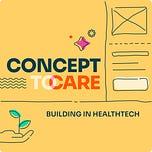Today on Concept to Care, we're joined by Rik Renard.
Rik is the Director of Clinical Strategy at Awell, a low-code platform to design, orchestrate and improve care flows in days, rather than months. He's also the founding force behind CareOps, an initiative from Awell in partnership with the Health Tech Nerds community.
In this insightful conversation, we'll explore Rik's unique journey - from dedicated clinician nurse to health tech operator. We'll dive into how Awell intelligently designs care flows to reduce variability and improve outcomes across the care continuum.
Rik will share candid insights on implementing change in environments resistant to new methods, and how to leverage data to validate whether care flows are achieving the desired results.
Perhaps most exciting, we'll learn firsthand from Rik about the origins of CareOps - the vision behind it and where this movement is headed next.
Some takeaways:
Helpful tips for boots on the ground people in care delivery who want to transition to a health tech care delivery organization:
Keep an eye out for organizations with strong purpose or mission and dedicate your efforts to behind a mission you care about
Adopt the mindset that you need to get comfortable with being uncomfortable to the most optimal outcomes
Invest in continuous improvement and continuous learning. You can achieve that by doing the following:
Following smart people around who either live and breathe this day to day or are an authority on a particular subject area within health tech
Read newsletters and listen to podcasts that discuss health tech topics
Take the initiative and create content that help share your thoughts, socialize your ideas, and create a venue for communication/engagement
Change management is critical to the success of a care flow implementation and the adoption of that care flow for the most optimal results. Here is how you deploy effective change management
Control the narrative and create shared accountability among the organization by making sure everyone knows exactly what you’re doing and why you’re doing it
Ask the clinicians executing the current care flows to document their flows and have them articulate the complexity of each activity (clinical vs transactional)
Motion to change the mindset of everyone around you. Challenge the status quo of how things are historically done and be flexible in changing that model for better outcomes
Awell is a back-end orchestration platform that empowers care organizations to continuously improve care flows quickly and at a low cost of delivery. Their platform:
Equips clinical organizations with the tooling to implement care flows and to continuously improve care flows efficiently over time
Reduces time to market and the overall cost of deploying care flows on a care organization’s patient population
Creates a space and a framework for generating fast insights and driving continuous iteration against any given care flow
Enables none engineers to design, publish, integrate care flows into a care organization’s technical eco-system, and make material impact on care teams and care flows
How Awell drives sales enablement and promotes adoption
They’ve created a category for themselves that they identify with and believe in, CareOps.
They’ve created demand around Care Ops by spreading the message of continuous improvement and continuous learning
They’ve embraced philosophies associated with CareOps, like DevOps
Best practices for designing care flows:
Care flows need to at least in some capacity be based on evidence-based-guidelines, peer review, CMS data, and internal data from your model
A care flow must be instrumented to provide real-time access to data that generates insights on how to improve the care flow
Embrace and adopt the mindset of continuous improvement. Always look for opportunities to make small improvements to any given care flow
Consider applying OODA Loop (Observe, Orient, Decide, and Act)
Avoid practicing “black box medicine”.
Tech enabled services organizations are notorious for practicing black box medicine. It’s more often than you think a tech enabled services organization is unable to explicitly share the casualty behind a particular outcome.
You can avoid practicing black box medicine by implementing a modern data stack to capture data being generated by your organization’s care flows and enable data science activities that can determine causality in performance improvement.
Note, there is no causality in the outcome. An outcome is a lagging indicator. A leading indicator comes from the care flow itself. Only there can you find causality.
The most important metric categories for an organization implementing care flows
Patient engagement metrics
Financial metrics
Clinician reported outcomes
Patient reported outcomes
Advice on contextualizing financial metrics to clinical teams and motivating them to think about them while they administer care
Create shared accountability in the metrics among the business and the clinical organization
Share ownership with the clinical organization by giving them a seat at the decision table and have them weigh in on matters relating to financial metrics
Identify value propositions that resonate with clinicians that will motivate them to care about a financial outcome (instead of driving stronger margins, we want to automate administrative workflows so that you can spend more time delivering care with patients)
Provide financial incentives to the clinical organization. Consider issuing equity or paying out cash bonus for efficiency
Hire the right people who inherently understand the value of good unit economics
—
Where to find Rik Renard:
LinkedIn: https://www.linkedin.com/in/rik-renard/
email: rik@awellhealth.com
CareOps Website: https://www.careops.org/
Awell Website: https://awellhealth.com/
—
Where to find Angela and Omar:
Angela Suthrave
Omar Mousa
—
Referenced:
CareOps: https://www.careops.org/
Awell: https://www.awellhealth.com/
Awell Developer Hub: https://developers.awellhealth.com/
Health Tech Nerds (HTN): https://www.healthtechnerds.com/
Hospitalogy: https://hospitalogy.com/
Healthcare Huddle: https://www.healthcarehuddle.com/
XPrimaryCare: https://www.xprimarycare.com/
Clinicians who VC: https://www.linkedin.com/posts/christinafarr_im-starting-a-community-for-clinicians-who-activity-7098361236970471424-Jved/
Using this McKinsey Framework (Situation-Complication-Resolution (SCR)) to create sales enablement: https://www.stratechi.com/situation-complication-resolution-scr-framework/#:~:text=McKinsey%20%26%20Company%20leverages%20the%20Situation,business%20environment%20and%20internal%20dynamics
Using the OODA Loop to help design care flows: https://thedecisionlab.com/reference-guide/computer-science/the-ooda-loop
The Book of Why: The New Science of Cause and Effect: https://a.co/d/dpGyHha
The Heart of Change: Real-Life Stories of How People Change Their Organizations: https://a.co/d/1FCUl78
Medplum: https://www.medplum.com/
Tava Health: https://www.tavahealth.com/
People mentioned
Thomas Casteele, CEO of Awell: https://www.linkedin.com/in/thomasvdc/
Blake Madden, Founder and Creator of Hospitality: https://www.linkedin.com/in/blakecmadden/
Jared Dashevsky, Resident Physician at Mount Sinai and Co-founder of Healthcare Huddle: https://www.linkedin.com/in/jareddash/
Kenneth Qiu, MD: https://www.linkedin.com/in/kenneth-qiu-md/
Chrissy Farr, Principal Investor, Health-Tech Lead at Omers Ventures: https://www.linkedin.com/in/christinafarr/
Arjun Arun, Senior Director, Data Governance & Management: https://www.linkedin.com/in/arjunrarun/
What is the Medicare Shared Savings Program: https://www.cms.gov/medicare/payment/fee-for-service-providers/shared-savings-program-ssp-acos/about
Example on how to brainstorm with ChatGPT: https://zapier.com/blog/chatgpt-for-brainstorming/
—
Check out our website: https://www.concepttocare.com
Follow us and Subscribe wherever you get your podcast:
















Share this post